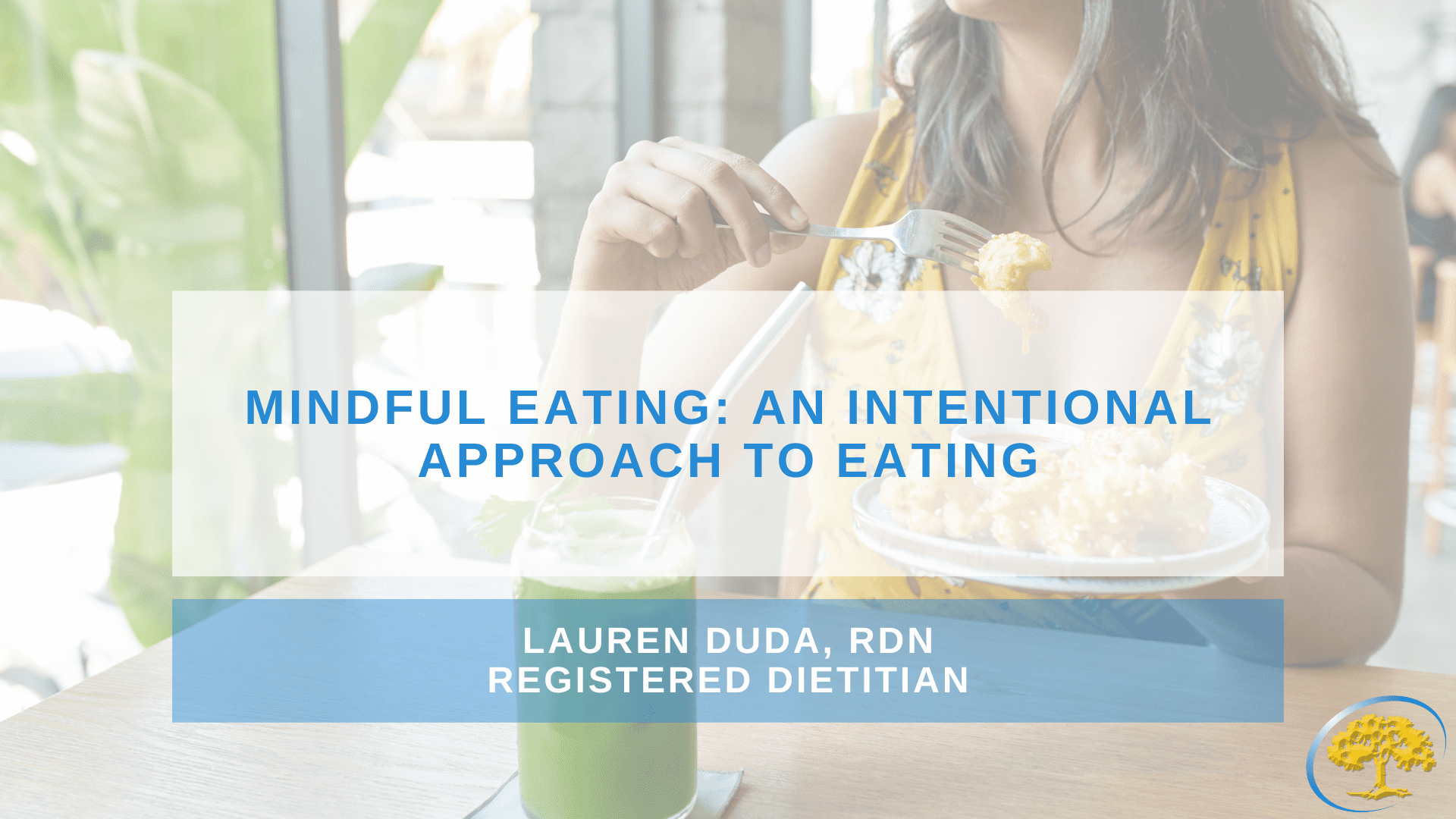
Posted 1 year ago
Mindful Eating: An Intentional Approach to Eating
In a society heavily focused on dieting, food rules, and weight loss programs, it is hard to imagine how to engage in eating without having to count calories, measure portions, or follow the latest fad. Diet culture presents eating as a structured way of eating, with an “eat this, not that” mentality. As easy as it is to simply eat—putting food in your mouth, chewing, and swallowing, there is so much more to eating than what meets the eye. In this month’s blog, we will be discussing an intentional approach to eating: mindful eating.
Eating is an individual practice and experience, varying from person to person. Beginning in childhood, we develop a unique relationship with food, which eventually influences our behaviors as we grow and become adults. In addition to our upbringing, the fast-paced environment we inhabit has an influence on our presence during mealtimes. We’re often rushed to eat due to our naturally busy lives, leaving us five minutes to scarf lunch. Mindful eating challenges this societally established “norm”. So, what exactly is mindful eating?
What is Mindful Eating?
Many of us are aware of the term “mindfulness”, which generally refers to the act of being conscious and aware of what we choose to focus on in that moment. According to the individual that coined the term, Jon Kabat-Zinn, mindfulness is “paying attention in a particular way, on purpose, in the present moment, and nonjudgmentally.” In this case, our mindfulness is geared towards being conscious of behaviors during the act of eating, called mindful eating.
Mindful eating is an approach that encourages the individual to fully immerse themselves in the eating experience and focus on the sensual aspects of the food(s) being consumed. With increased awareness during times of eating, we are better able to identify behaviors that we engage in, such as eating quickly, overeating, etc. Mindful eating can act as that first step in helping us become more conscious of our food-centered habits and reveal behaviors that we may want to adjust.
The purpose of mindful eating is to stray away from dieting. Diets are typically short-lived ways of eating that often focus on achieving a particular outcome, such as weight loss. Those who follow diets may find success with said outcomes, but they often don’t last, as most diets tend to be restrictive and hard to manage in the long term. Diets are also heavily rule-focused and are usually accompanied by some form of measurement…again, outcome focused. The refreshing part of mindful eating is that it is NOT a diet. The overarching goal of mindful eating is to create an individualized experience driven by physiological cues and senses, no measuring or counting required! Let’s dive a little further into how it works.
How does Mindful Eating Work?
Now that the concept of mindful eating has been explained, how can we incorporate this approach in day-to-day life? Mindful eating begins well before we physically put food in our mouths—it begins when we notice first signs of hunger and/or a desire to eat. For most, the reason why we’re truly eating is not a typical thought, and we could be eating for many reasons aside from feeling physical hunger. Other “hunger triggers” could include emotional hunger, stress, boredom, and even facing tough situations. As a dietitian, I encourage patients to pause and reflect on their reason for eating to identify if it is a physical hunger versus emotional hunger. By practicing this, individuals can better recognize their patterns and behaviors with eating, and therefore, make more informed choices.
Let’s say the “why” has been distinguished, and we decide we would like to eat. It’s time to set up an ideal environment that can foster mindfulness. As previously mentioned, we live in a fast-paced environment where we may find ourselves more mindless and not fully invested in focusing on mealtime. To achieve the best setting, we want to eliminate distractions. Distractions can include watching TV, being on the phone, driving, and any external stimulus that would cause focus to shift away from the eating experience. Our goal is creating a calm, non-distracting environment to best practice mindfulness. Therefore, it may be helpful to be aware of where you are currently eating and consider adjusting the setting. An ideal environment could be the dinner table with the TV turned off and phones away from the table.
Once the “why” and “where” are established, we can now switch our focus to the food itself and start eating. As previously stated, mindful eating is about immersing ourselves in the present moment. Let your senses tell the story, using smell, taste, sight, and feeling to fuel this unique eating experience. It is helpful to perform adequate chewing and pausing between bites of food—it’s okay to take your time and savor each bite! While eating, check in with yourself and begin to assess your fullness. Are you satisfied with the amount you’ve consumed, or could you eat more? A useful tool to better gauge your hunger and fullness is the Hunger and Fullness Scale. We can assess our hunger and fullness at any point in time during the eating process by assigning our hunger/fullness a number that correlates with the description provided. By noticing satisfaction, this can assist in avoiding overeating and feeling uncomfortable and/or stuffed. It’s a great idea to experiment with different levels of fullness, as physical cues can differ from person to person. As I like to tell patients, every time you eat is a time to practice, so no worries if we overeat this time; we have another opportunity to practice the next time we eat! Feel free to try with the Hunger and Fullness Scale below.
Practicing mindful eating can offer a new perspective on the eating experience and can help with fostering a healthy relationship with food and our bodies. This approach can be empowering because we are in control of our decisions around food and are able to create our own unique eating approach that works for us. Mindful eating challenges individuals to veer away from dieting and restriction and embrace and appreciate what eating truly has to offer.
Lauren Duda, RD

Lauren’s interest in nutrition peaked at the age of 14, when she experienced a personal journey in developing her relationship with food. She decided that she wanted to help people like herself and educate the general public about nutrition. Becoming a registered dietitian was a clear career path and quickly became a dream of hers at a young age. Throughout the years, Lauren began to realize how necessary nutrition is in the management of disease, especially when witnessing her family members experience major health concerns. With this deepening her desire to care for others, Lauren ultimately knew that it was her goal to provide nutrition therapy in way that also values empathy, compassion, and kindness.
When she’s not working, Lauren loves spending her free time with friends, family, and her dog, Zeppelin. She enjoys listening to music, attending concerts, styling clothes, and hiking/biking during the cooler months.

